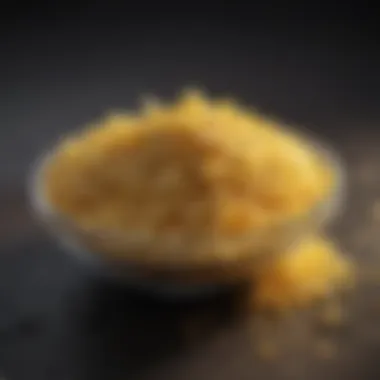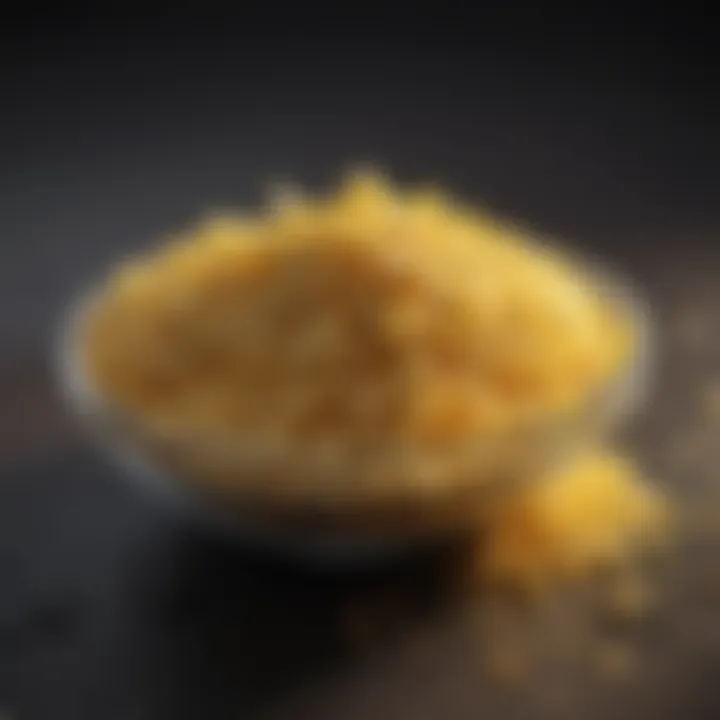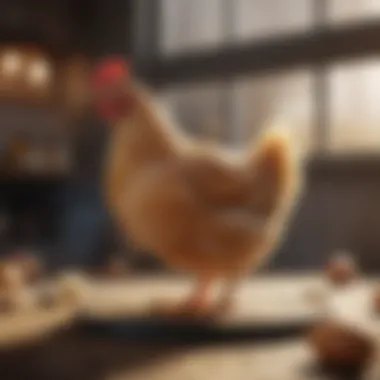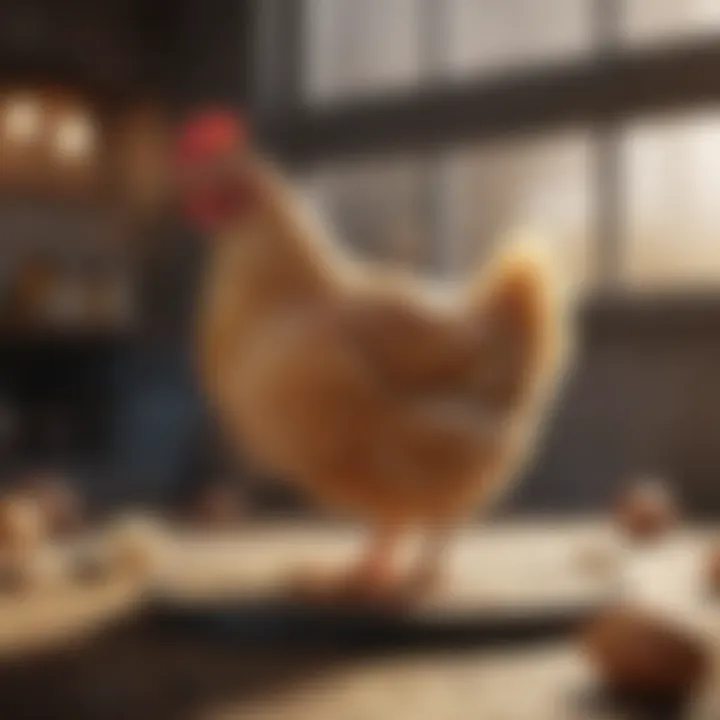Key Ingredients of Medicated Chick Starter Feed


Intro
Understanding the components of medicated chick starter feed is essential not just for poultry farmers but also for those who are simply raising chickens as a hobby. This particular feed type is specially formulated to support the rapid growth and robust health of young chicks, giving them the best start possible in life. Without proper nutrition at this crucial stage, the risk of disease and poor development increases significantly.
Importance of the Topic
The significance of medicated chick starter lies in its dual purpose: nourishing the young birds while also protecting them against potential ailments. It typically contains a blend of proteins, vitamins, minerals, and specific medications that fend off common diseases that could threaten the chicks’ health and livelihood. By delving into the richness of its formulation, we not only unlock the secret to raising healthy chicks but also contribute to a thriving poultry industry.
A well-rounded diet ensures that each chick starts off strong, which is vital for their growth and sustainability as they mature into productive members of any flock.
Intro to Medicated Chick Starter
When it comes to raising healthy chicks, understanding the foundational components of medicated chick starter feed is essential. This section seeks to shed light on why this topic holds such weight in poultry husbandry, emphasizing the integral role it plays in both chick growth and overall flock health. A well-formulated starter feed not only fuels rapid growth but also lays the groundwork for robust immune systems in young chickens.
Defining Medicated Chick Starter
Medicated chick starter is specifically designed feed for baby chickens, aiming to bridge the nutritional gap they face during their early stages. It typically contains a mixture of grains, proteins, vitamins, and minerals. What sets it apart is its inclusion of medicating agents, which are intended to prevent common health issues that may arise during a chick's most vulnerable period.
This type of feed often combines essential nutrients with medications that serve to fight off infections and boost overall vitality. Bottom line, medicated chick starter is not just about nourishment; it’s about setting the stage for strong, healthy birds.
Purpose and Benefits of Medicated Feeds
The purpose of medicated feeds lies primarily in prevention. Raising poultry comes with the risk of several diseases, especially in young birds. By incorporating medicating agents, such as antibiotics and coccidiostats, into chick starter, farmers aim to mitigate these risks. Here are a few key benefits of using medicated feeds:
- Disease Prevention: Young chicks often encounter stress from environmental changes or feed transitions, making them susceptible to infections. Medicated feeds help bolster their defenses.
- Improved Growth Rates: With better health comes better growth. Chicks fed medicated starter often show significantly enhanced growth rates due to a healthier start to their lives.
- Enhanced Feed Efficiency: Medicated feeds enable chicks to convert feed into body mass more effectively, maximizing the productivity of feed resources.
"The right care at the right time makes all the difference in poultry farming. Investing in good starter feed is a prime example."
In summary, the introduction of medicated chick starter is a cornerstone of poultry management. By recognizing its definitions and benefits, poultry enthusiasts are better equipped to make informed choices that will ensure the health and productivity of their flocks.
Key Ingredients in Medicated Chick Starter
Medicated chick starter feed is indispensable for anyone serious about raising poultry. This section uncovers the key ingredients that play a pivotal role in the formulation of this essential feed. By understanding these key components, housewives and homeowners can make informed decisions that positively impact the health and growth of their chicks.
Grains as a Primary Component
Grains are the cornerstone of any chick starter, providing a substantial base for the diet. Corn, wheat, and barley often find their way into these mixtures. Grains are vital because they are rich in carbohydrates, which promote energy levels and general vitality in growing birds.
A few things to consider:
- Energy source: Grains provide the energy necessary for daily activities. This is crucial as chicks rapidly grow and require significant energy to keep pace.
- Digestibility: These ingredients are typically easy for chicks to digest; however, the manner in which they are processed can significantly impact their digestibility.
- Cost-effectiveness: Grains are also relatively inexpensive, making them an economically sound choice for feed formulation.
However, not all grains are created equal. For instance, feeding too much corn could lead to an imbalanced diet, since it lacks some essential nutrients that other grains might deliver. Experts suggest a well-rounded mix of grains to ensure chicks receive diverse nutrients.
Protein Sources: Essential Elements
Protein is essential for the growth and development of chicks. It supports muscle development and tissue repair, which is crucial during the early stages of a chick's life. Common protein sources include soybean meal, fish meal, and meat by-products. These ingredients deliver amino acids vital for health.
Key points regarding protein sources include:
- Animal versus plant protein: Each type has its own set of advantages. Animal proteins are typically high in specific amino acids like lysine, while plant sources, like soybean meal, can be lower in such nutrients. A blend often works best for optimal nutrition.
- Quality matters: Not all protein sources are of the same quality. For example, fish meal should be sourced from reputable providers to ensure freshness and nutritional integrity.
- Balanced diets: Too little protein can stunt growth, while too much can lead to health complications. Finding the right balance is key.


To give an example of what a balanced chick starter might look like, consider that a typical formulation might include 20% protein coming from a mix of soybean and fish meal, ensuring a broader range of amino acids while supporting good health.
By being well-informed about the grains and proteins used in medicated chick starters, individuals looking after their chickens can enhance growth rates and support overall well-being.
Vitamins and Minerals in Medicated Feed
When it comes to the health and vitality of chicks, vitamins and minerals play a critical role in their development. Incorporating these essential nutrients into medicated chick starter feed is not just a matter of routine. It’s about making sure that young chicks have all they need to thrive in their formative weeks. Without proper vitamins and minerals, growth stunts, disease resistance weakens, and the overall well-being of chicks can deteriorate. In this section, we’ll dive deeper into the key vitamins and minerals that are indispensable for chicks—both for their immediate growth needs and long-term health.
Vitally Important Vitamins
Vitamin A
Vitamin A is the superstar of vitamins when it comes to maintaining good eyesight, especially in young chicks. It plays an important role in immune function and cell growth. Chickens, like many other animals, cannot synthesize Vitamin A on their own, so it must be included in their diet. It’s particularly beneficial as it promotes feather growth, and healthy feathers are crucial for insulation and protection.
A unique characteristic of Vitamin A is its fat-solubility, which allows it to be stored in the liver and released slowly as needed. However, there’s a fine line; while adequate levels promote good health, excess can lead to toxicity. Balancing Vitamin A in feed formulations is a delicate task that requires careful consideration of the overall diet.
Vitamin
Vitamin D is another vital player, particularly known for its role in calcium absorption and utilization. This vitamin ensures that not only is calcium available but also that chicks can use that calcium efficiently to form strong bones. This is essential, as weak bones can lead to deformities and physical issues down the line.
The provision of Vitamin D through natural sunlight and dietary inclusion is a common approach, yet the challenge arises in indoor settings where chicks might not receive enough sunlight. Thus, including sources of Vitamin D through medicated feeds becomes essential. One key feature to note is that unlike some other vitamins, Vitamin D can be synthesized by the chick when exposed to sunlight, but in controlled environments, it must come from feed to ensure optimal growth.
Vitamin K
Vitamin K is often overlooked, but it’s crucial when it comes to blood clotting and bone health. For chicks, a sufficient amount of Vitamin K can be a game-changer, particularly in preventing hemorrhages. It helps in the synthesis of proteins required for blood coagulation, ultimately safeguarding the chicks as they grow.
One of the unique features of Vitamin K is its storage form; it’s stored in liver tissue but is also rapidly depleted if not supplied in the diet over time. When considering medicated feeds, ensuring that Vitamin K is included is beneficial for overall growth and reduces the associated risks of bleeding disorders in the young birds.
Minerals for Growth and Development
Calcium
Calcium is often synonymous with healthy bones and eggshell formation in layers, but its importance for growing chicks cannot be overstated. A key aspect of calcium is its role in muscle function and nerve transmission as well. The demand for calcium increases as chicks develop, particularly around the time of their maturation.
Including an adequate amount of calcium in medicated chick starter feeds supports skeletal formation and muscular health. One popular choice is limestone, though it needs to be balanced with phosphorus to maximize absorption. Too much calcium can lead to renal issues; thus, careful monitoring is required.
Phosphorus
Phosphorus complements calcium in its function in bone health. It aids in energy transfer through ATP and contributes to the formation of DNA and RNA. This means that phosphorus isn’t just about strong bones; it’s also about cellular function and energy balance, which are essential for growing chicks.
The key characteristic of phosphorus is that it works best when paired with calcium in appropriate ratios. This partnership helps ensure that chicks grow strong and healthy but requires careful attention to their intake.
Trace Minerals
Trace minerals, such as zinc, manganese, and selenium, might not be abundant in feed, yet their impact is substantial. Each trace mineral contributes uniquely to the metabolic processes in chicks. For instance, selenium acts as a powerful antioxidant, while zinc boosts immune function and supports various enzymatic reactions.
These minerals are often present in medicated feeds in minute quantities, but their effectiveness hinges on balance. For example, while a little goes a long way, excessive intake can lead to deficiencies in other minerals due to competitive absorption. This complex balancing act requires a solid understanding of nutritional science when formulating chick starter feeds.
Essentially, the right mix of vitamins and minerals lays the groundwork for robust poultry health. By fostering an environment rich in these nutrients, poultry producers can set their chicks on the path to success, ultimately ensuring not just survival but flourishing development.
Medicating Agents: Overview and Types
Medicating agents play an essential role in chick starter feeds, especially for young poultry. Their primary function is to promote health and mitigate the risk of diseases. With the stress that comes from transitioning into new environments and dietary changes, chicks are vulnerable. Effective medicating agents can alleviate some of these pressures and support their overall well-being.


Antibiotics as a Common Component
Mechanism of Action
Antibiotics work by inhibiting bacterial growth or killing bacteria altogether. This is crucial in medicated feeds, as it can prevent the development of diseases that might hinder the chicks' growth. One significant characteristic of antibiotics is their ability to target specific bacteria without causing a substantial disruption to other beneficial microorganisms within the gut. This selective action makes them a popular choice in the formulation of medicated chick starters. However, there’s a downside: over-reliance on antibiotics can lead to antibiotic resistance. This unique feature requires chick feed producers to carefully weigh the benefits and risks involved.
Common Antibiotics Used
When it comes to common antibiotics included in chick starter feeds, Chlortetracycline and Oxytetracycline are often found. They serve as effective tools to enhance growth and prevent disease in chicks. A notable characteristic of these antibiotics is their broad-spectrum effectiveness, which means they can tackle a variety of bacterial infections. This broad action is significant for raising healthy poultry. Nevertheless, it's imperative to monitor their usage closely. Over-utilization can pose risks to the overall health of chicken populations and raise concerns about residues in meat and eggs.
Coccidiostats and Their Role
Coccidiostats are another crucial medicating agent in chick starter feeds. Their primary function is to control coccidiosis, a disease caused by protozoan parasites. These parasites can lead to significant health issues and even mortality in chicks. Coccidiostats prevent the establishment of these parasites in the gastrointestinal tract, effectively safeguarding chick health. By doing so, they support better feed efficiency and growth rates.
In summary, medicating agents like antibiotics and coccidiostats serve vital functions in chick starter feeds. Their unique mechanisms and characteristics not only promote health but also enhance the overall productivity of poultry. Properly using these agents, while staying aware of their implications, is crucial for the successful raising of healthy chicks.
Balancing Nutrition in Chick Starter Feeds
Balancing nutrition in chick starter feeds is a crucial aspect of poultry management. Getting this right forms the backbone of animal health and productivity. A well-balanced diet influences everything from growth rates to the immune response of chicks, making it essential for poultry keepers to pay close attention to the nutritional composition of their feeds.
When formulating a diet for young chicks, considerations should include key macronutrients, micronutrients, and additives, all working in harmony to create a holistic nutrition profile. This optimization helps ensure that chicks not only grow at an appropriate rate but also thrive, keeping health issues at bay.
Formulating Balanced Diets
Creating balanced diets involves several steps. You begin by understanding the specific needs of the chicks based on their age, breed, and expected growth rates. Each flock may have differing requirements that must be tailored for optimal results.
- Protein is one of the main ingredients. Young chicks require a higher protein content initially to support their rapid growth and development.
- Carbohydrates provide energy, helping chicks remain active as they explore their surroundings.
- Fats also play a role in energy supply, but they should be included thoughtfully. Too much fat can lead to obesity, while too little can hinder energy levels.
The balance between these components needs to reflect the natural behavior and needs of the chicks. A common mistake is undervaluing the role of proper nutrition in equipping chicks to tackle their environment successfully.
The Role of Feed Additives
Feed additives can enhance the nutritional profile of chick starter feeds and promote better health. When selected carefully, these aids can bolster performance and fortify the immune system. Two primary categories of feed additives are probiotics and enzymes, each playing unique roles in feed efficiency and overall well-being.
Probiotics
Probiotics are live microorganisms that, when administered in adequate amounts, confer a health benefit on the host. In the context of chick feed, these beneficial bacteria help sustain a balanced gut microbiota. A well-populated gut flora contributes to better digestion, leading to improved nutrient absorption. This is crucial for young chicks, who often have developing digestive systems.
- Key characteristic: They facilitate digestion and help fend off harmful bacteria, thus preventing gut-related diseases.
- Why a beneficial choice: Probiotics can lower the incidence of clinical disorders related to gut health, leading to reduced antibiotic use and thereby less risk of antibiotic resistance.
- Unique feature: They not only support immunity but can enhance growth performance, which is certainly advantageous for poultry producers looking to increase output.
Enzymes
Enzymes act as catalysts for various biochemical reactions, increasing the digestibility of feed ingredients. By breaking down complex nutrients into simpler forms, they help chicks make the most of their feed. The incorporation of enzymes can be particularly useful when high-fiber feed ingredients are used.
- Key characteristic: They significantly boost energy and nutrient availability in feeds, making it easier for chicks to absorb important nutrients.
- Why a beneficial choice: Enzymes can reduce feed costs because they allow for more efficient use of raw materials, helping producers optimize their budgets while still providing quality nutrition.
- Unique feature: They can also improve the overall health of chicks through better digestion, reducing the risk of metabolic disorders.
Balancing nutrition in chick starter feeds isn't just about meeting basic requirements; it's about setting a solid foundation for a lifetime of good health and productivity.
The thoughtful incorporation of these elements and carefully selected feed additives ultimately lead to nourished, thriving chicks. The poultry business is challenging; thus, investing time and resources into balanced feeding will pay dividends in the long run, providing healthier birds and, by extension, better returns.
Impact of Quality Ingredients on Chick Health
The selection of quality ingredients in medicated chick starter feed holds paramount importance, acting as a foundation for the overall health, growth, and development of young chicks. When these birds receive premium nutrients at their early stages, the positive consequences can ripple throughout their lives, paving the way for healthier flocks and more productive outcomes for poultry farmers. In the following sections, we will delve into how nutrition influences growth rates, as well as its critical role in preventing diseases among chicks.


Nutrition's Influence on Growth Rates
Growth rates among chicks can be significantly affected by the quality of nutrition they receive. Quality ingredients not only provide essential nutrients but also influence the efficiency of nutrient absorption. When chicks consume feeds rich in nutrients like amino acids, vitamins, and minerals, their bodies can develop properly. For example, a high-quality protein source helps build muscle mass, which is vital for their growth.
Moreover, research indicates that chicks given superior feed tend to reach their target weights sooner compared to those on inferior diets. This faster growth leads to better feed conversion ratios, meaning that less feed is wasted while more energy translates into growth. Farmers looking to optimize their production can see notable differences when implementing a well-formulated medicated chick starter feed.
"Healthy chicks are the cornerstone of a successful poultry operation. Investing in quality feed pays off in the long run."
Conditions and management practices on the farm also play a part. A stressed chick or one with health issues will not achieve the same growth as a well-nourished, healthy bird. Therefore, a focus on ingredient quality in medicated feeds is not just about immediate growth but rather about setting up a chick for lifelong health.
Disease Prevention Through Proper Nutrition
Preventing diseases through proper nutrition is a cornerstone of raising healthy chicks. Quality medicated feed can boost the immune system, making it more resilient against pathogens. Nutritional deficiencies can leave chicks vulnerable to various ailments, which can adversely affect production and lead to increased costs for the farmer due to medication and treatment expenses.
Including immunomodulators alongside vitamins can significantly enhance immunity. For instance, the inclusion of essential fats can support cellular functions and immune responsiveness. Additionally, antioxidants play a crucial role by combating oxidative stress, which is linked to various health complications.
Furthermore, ensuring that chicks receive a balanced profile of nutrients helps in decreasing mortality rates and ensuring lower incidence of diseases, enabling farmers to achieve a more stable return on investment.
To summarize, the quality of ingredients in medicated chick starter feeds can't be overstated. These components are integral not just for immediate growth but also for long-term health and productivity, ensuring a sustainable poultry operation that benefits both the farmer and the meat or egg consumers alike.
Regulations and Considerations for Medicated Feeds
Understanding the landscape of medicated feed regulations is critical for anyone involved in poultry farming. These regulations exist primarily to ensure both the safety of the animals and the quality of the food we all consume. With the increasing complexities of poultry nutrition, housewives and homeowners looking to delve into this area must pay heed to various factors.
Understanding Feed Regulations
Feed regulations can span a wide array of aspects, from ingredient sourcing to labeling and permissible medication levels. In many countries, governmental bodies provide specific guidelines that define what constitutes safe and effective medicated feeds. For instance, the United States Food and Drug Administration (FDA) sets standards for feed formulations, including the types and amounts of medicinal ingredients.
While delving into the specific requirements, it’s worth focusing on a few critical elements:
- Labeling Requirements: Understanding how to read labels can help you avoid feeds with unapproved substances. Labels must clearly indicate the type and quantity of medicating agents, helping ensure compliance with safety standards.
- Ingredient Sourcing: Regulations often demand that all ingredients meet certain health standards. Sourcing from reputable suppliers who follow Good Manufacturing Practices (GMP) can minimize risks.
- Record Keeping: Many regulations require farm owners to maintain comprehensive records of feed purchases and animal treatments. This can be quite useful for tracking treatment history and managing flock health in a detailed manner.
These regulations not only serve the animals by preventing disease outbreaks and ensuring their wellbeing but also protect consumers from potential residues in meat and eggs.
Safe Use of Medicated Feeds
Using medicated feeds safely is paramount. While they are intended to promote health, improper use can lead to antibiotic resistance or other health risks. Here are some considerations to keep in mind:
- Follow Recommendations: Adhering to the manufacturer’s guidelines regarding dosages and feeding schedules is essential. Over-medication can harm animal health and lead to residues if animals are sent to market too soon.
- Monitor Flock Health: Regularly observe your chicks for any signs of distress or adverse reactions. This allows for quicker interventions if something seems amiss.
- Rotate Medications: If using medicated feeds regularly, it can be beneficial to rotate products to minimize the risk of resistance development in the bacterial populations within the flock.
Properly managing medicated feeds ensures that the benefits outweigh the risks and supports a sustainable approach to poultry farming.
The End and Takeaways
In summing up the components of medicated chick starter, it's clear that every element plays a critical role in the health and growth of young chicks. Not only do these feeds ensure adequate nutrition, but they also incorporate essential medicating agents that help prevent diseases that can affect poultry early in life. This dual function of promoting well-being while offering protection can't be overstated, especially when you consider how foundational good nutrition is for the future productivity of hens and roosters.
Recap of Key Points
- Nutritional Balance: A well-formulated medicated chick starter must provide a balanced ratio of protein, fats, and carbohydrates. This balance is integral to supporting the rapid growth stages of chicks.
- Vital Nutrients: Vitamins and minerals, including calcium, phosphorus, and essential vitamins, contribute to strong skeletal development and overall vitality.
- Medicating Agents: The inclusion of antibiotics and coccidiostats is aimed at reducing the risk of infections and ensuring that chicks can focus their energy on growth rather than fighting off illnesses.
- Regulatory Compliance: Understanding the regulatory landscape is important for safe implementation. Adhering to guidelines ensures both the safety and effectiveness of medicated feeds.
Understanding these key components allows poultry keepers to make informed decisions about their chicks’ diets, influencing overall flock health and productivity in the long run.
Future Directions in Poultry Nutrition
As we look ahead, the landscape of poultry nutrition is evolving rapidly. Research continues to unveil new methods and approaches to enhance feed composition. Here are a few trends that merit attention:
- Natural Alternatives: With increasing interest in organic and natural farming solutions, future feeds might turn towards more natural medicating agents. This shift could address consumer concerns about antibiotic resistance and chemical residues in poultry products.
- Precision Nutrition: Advances in technology could lead to more tailored feeding programs based on individual chick needs, which ensures optimal growth rates without waste.
- Sustainability Practices: As the push for sustainability grows, feed formulations that utilize by-products or have a lower environmental footprint are likely to gain traction. This approach not only benefits the environment but could also lower costs for producers.
Looking into the future, poultry nutrition is set to become more sophisticated, with a focus on health, sustainability, and efficacy. Keeping abreast of these changes will help poultry keepers ensure that their flocks remain healthy and productive.







